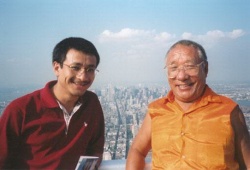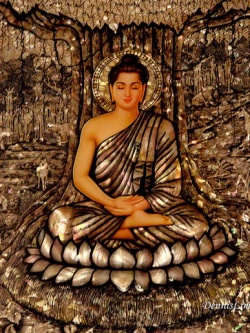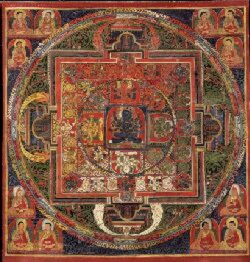Difference between revisions of "Shentong – An Introduction"
m (Text replacement - "the subject" to "the subject") |
m (Text replacement - "authentic" to "authentic") |
||
| Line 24: | Line 24: | ||
Just like every appearance in the [[relative]] [[world]] is [[empty]] of itself, the [[clear light]] is [[empty]] of “adventitious, fleeting stains,” glo-bur-gyi-dri-ma-med-pa. In other words, the [[clear light]] is “[[empty]] of adventitious, fleeting [[thoughts]],” glo-bur-gyi-rnam-rtog-med-pa. Proponents of the empty-of-other [[view]] are [[masters]] and [[disciples]] of what has come to be known as gzhan-stong-dbu-ma, the “[[Shentong]] ‘Great’ [[Madhyamika]] School.”3 | Just like every appearance in the [[relative]] [[world]] is [[empty]] of itself, the [[clear light]] is [[empty]] of “adventitious, fleeting stains,” glo-bur-gyi-dri-ma-med-pa. In other words, the [[clear light]] is “[[empty]] of adventitious, fleeting [[thoughts]],” glo-bur-gyi-rnam-rtog-med-pa. Proponents of the empty-of-other [[view]] are [[masters]] and [[disciples]] of what has come to be known as gzhan-stong-dbu-ma, the “[[Shentong]] ‘Great’ [[Madhyamika]] School.”3 | ||
[[File:57Guhyasamaja.jpg|thumb|250px|]] | [[File:57Guhyasamaja.jpg|thumb|250px|]] | ||
| − | Since the mind’s [[essence]] is [[primordially pure]] and free of stains that are other than the mind’s [[essence]], mind’s [[true nature]] is referred to as “[[transcendent]] [[perfection]] of | + | Since the mind’s [[essence]] is [[primordially pure]] and free of stains that are other than the mind’s [[essence]], mind’s [[true nature]] is referred to as “[[transcendent]] [[perfection]] of authentic [[purity]].” Since the mind’s [[essence]] is other than the [[self]] that one believes in and clings to and since the mind’s [[essence]] is other than [[non-self]] or [[selflessness]] discovered through [[inference]] and deduction, mind’s [[true nature]] is referred to as “the genuine [[self]].” But how can stains of erroneous notions about it conceal mind’s [[true nature]]? Mind’s [[true nature]] is beyond the [[self]] one [[thinks]] one [[perceives]] and then imputes to be real and it is beyond the notion of [[selflessness]] one [[thinks]] one has discovered through [[logical]] {{Wiki|reasoning}}. Mind’s [[true nature]] is called “genuine [[self]]” since it is beyond any assumptions of both a [[self]] as well as [[non-self]] or [[selflessness]]. |
[[Samsara]] and [[nirvana]] are conceptualised and imputed in reciprocal dependence upon each other and therefore neither the one or the other is independent, i.e., [[samsara]] and [[nirvana]] depend upon each other. When a practitioner sees the equality and undivided nature of [[samsara]] and [[nirvana]] by having [[realized]] that the [[essence]] of both is [[emptiness]], then he or she has [[realized]] [[transcendent]] [[perfection]] of real permanence. [[Happiness]] and [[suffering]] are conceptualised and imputed in reciprocal dependence upon each other, too, and therefore neither the one or the other is independent, i.e., [[happiness]] and [[suffering]] depend upon each other. When a practitioner sees the equality and undivided nature of [[happiness]] and [[suffering]] by having [[realized]] that the [[essence]] of both is [[emptiness]], then he or she has [[realized]] [[transcendent]] [[perfection]] of [[bliss]]. Then the [[transcendent]] [[self]], [[unchanging]] permanence, and [[pure]] [[bliss]] have been “fully established,” yongs-grub.4 | [[Samsara]] and [[nirvana]] are conceptualised and imputed in reciprocal dependence upon each other and therefore neither the one or the other is independent, i.e., [[samsara]] and [[nirvana]] depend upon each other. When a practitioner sees the equality and undivided nature of [[samsara]] and [[nirvana]] by having [[realized]] that the [[essence]] of both is [[emptiness]], then he or she has [[realized]] [[transcendent]] [[perfection]] of real permanence. [[Happiness]] and [[suffering]] are conceptualised and imputed in reciprocal dependence upon each other, too, and therefore neither the one or the other is independent, i.e., [[happiness]] and [[suffering]] depend upon each other. When a practitioner sees the equality and undivided nature of [[happiness]] and [[suffering]] by having [[realized]] that the [[essence]] of both is [[emptiness]], then he or she has [[realized]] [[transcendent]] [[perfection]] of [[bliss]]. Then the [[transcendent]] [[self]], [[unchanging]] permanence, and [[pure]] [[bliss]] have been “fully established,” yongs-grub.4 | ||
Revision as of 10:00, 12 September 2013
Khenpo Tsultrim Gyatso Rinpoche
Shentong – An Introduction
Translated by Ari Goldfield
Before listening to Lord Buddha’s teachings, I want to ask you to give rise to supreme bodhicitta. Supreme bodhicitta is generated and increased by first thinking of one’s father and mother in this life and then extending the gratitude and love one feels for them to all sentient beings, even to one’s enemies. We want to attain the state of complete, perfect, and precious enlightenment for their sake. We know that in order to be able to benefit all sentient beings, we need to listen to, reflect, and meditate upon the genuine Dharma teachings with all the enthusiasm we can muster in our hearts. Please give rise to supreme bodhicitta when you listen attentively.
We think of our parents first, because the fact that we are able to practice the Dharma in this lifetime is due to the immense kindness they have shown us. We think of our enemies, too, because they are the ones who give us the exceptional opportunity to practice patience when they are unkind and hurt us. Furthermore, there is not a single enemy who was not our caring father or mother at one time in the past, so that is why we remember them with gratitude. We think of the nature of the minds of the people we are associated with - our friends, our enemies, and all sentient beings. We know that every single sentient being’s nature of mind is clear light, the enlightened heart that is the Buddha nature. Since everyone has Buddha nature, we can be sure that we will benefit others immensely. Just as the nature of our own mind is clear light, the nature of our parent’s minds is also clear light. Likewise, the nature of mind of all our friends and enemies is clear light. The nature of mind of every single sentient being is luminosity, clear light.
In the nature of the mind there is no stain. There is not the slightest conceptual fabrication in the mind’s true nature, and that is why mind is known as “empty of other,” gzhan-stong. Since the ineffable nature of mind of every single sentient being is clear light and since the essence of this clear light is free of the slightest stain that arises due to dualistic fixations and mental constructs, one can develop the vast understanding that the one who apprehends (the subject) and what is apprehended (objects) have the same essence. Knowing this enables practitioners to develop inconceivable compassion and a pure vision of reality. Knowing that relative apprehensions are “self-empty,” rang-stong, and knowing that mind’s true nature is “empty of other,” gzhan-stong, a sincere practitioner no longer slips into garments that are extreme views about creation or cessation. Seeing that all phenomena that can be apprehended are empty of an own essence, one no longer clings to the extreme of permanence. Seeing that mind’s true nature is replete with many invaluable qualities that manifest spontaneously and naturally, one no longer clings to the extreme of nihilism or cessation. Since all relative phenomena that appear are empty of a self, it is conclusive that the mind that apprehends and conceives relative appearances is also empty of a self. Since mind’s true nature transcends what can be accomplished, affirmed, or refuted, then what one thinks must be accomplished and what one thinks must be abandoned are always and already pure and free.
It is taught that if one overcomes beliefs in a truly existing self, in truly existing mental afflictions, in truly existing difficulties, in truly existing suffering, and so forth, then one will have peace. But since everything is empty of an own essence already, then why worry about momentary mental constructs regarding things that need to be abandoned or not abandoned? Nobody has ever seen nor was able to prove that thoughts about abandoning and not abandoning arise and cease, i.e., come and go. Nobody has ever perceived these thoughts and never will, because their nature is emptiness. Doubts as to whether thoughts are born and cease again cannot be said to be the results of either bondage or of liberation. However, momentary perceptions and apprehensions are solidified through resulting temporary conceptions by insisting that what was apprehended denotes either bondage or liberation. Just like thoughts that arise in a dream, ideas about bondage and liberation are merely imagined, kun-brtags.1
Everyone, even those beings who are entangled and bound in mental constructs, has no perceptible essence. Doubts that arise in the mind of a practitioner and that keep him or her in bondage can never be found to arise or cease. Thoughts about bondage depend upon thoughts about liberation and vice versa. Concepts merely arise in the mind and are ever dependent upon each other, gzhan-dbang.2
Let clinging to all constructed limitations subside into the unborn expanse of dharmadhatu – spros-pa-mtha'-dag-chos-dbyings-su-nub-pa.
Since this life is appearance-emptiness and like a reflection of the moon on a pond, past and future lives are also appearance-emptiness and like reflections of moons on ponds. Feeling happy and feeling sad are just like thoughts that arise in a dream. If we know this well, then we will have realized the profound view, which is wisdom devoid of all mental fabrications - spros-pa-thams-cad-dang-bral-ba'i-ye-shes.
Just like every appearance in the relative world is empty of itself, the clear light is empty of “adventitious, fleeting stains,” glo-bur-gyi-dri-ma-med-pa. In other words, the clear light is “empty of adventitious, fleeting thoughts,” glo-bur-gyi-rnam-rtog-med-pa. Proponents of the empty-of-other view are masters and disciples of what has come to be known as gzhan-stong-dbu-ma, the “Shentong ‘Great’ Madhyamika School.”3
Since the mind’s essence is primordially pure and free of stains that are other than the mind’s essence, mind’s true nature is referred to as “transcendent perfection of authentic purity.” Since the mind’s essence is other than the self that one believes in and clings to and since the mind’s essence is other than non-self or selflessness discovered through inference and deduction, mind’s true nature is referred to as “the genuine self.” But how can stains of erroneous notions about it conceal mind’s true nature? Mind’s true nature is beyond the self one thinks one perceives and then imputes to be real and it is beyond the notion of selflessness one thinks one has discovered through logical reasoning. Mind’s true nature is called “genuine self” since it is beyond any assumptions of both a self as well as non-self or selflessness.
Samsara and nirvana are conceptualised and imputed in reciprocal dependence upon each other and therefore neither the one or the other is independent, i.e., samsara and nirvana depend upon each other. When a practitioner sees the equality and undivided nature of samsara and nirvana by having realized that the essence of both is emptiness, then he or she has realized transcendent perfection of real permanence. Happiness and suffering are conceptualised and imputed in reciprocal dependence upon each other, too, and therefore neither the one or the other is independent, i.e., happiness and suffering depend upon each other. When a practitioner sees the equality and undivided nature of happiness and suffering by having realized that the essence of both is emptiness, then he or she has realized transcendent perfection of bliss. Then the transcendent self, unchanging permanence, and pure bliss have been “fully established,” yongs-grub.4
This was a brief explanation of the way relative appearances and experiences are empty of self, rang-stong, and the way true reality is empty of other, gzhan-stong.
May all of you realize the true nature of mind
that is steadfast, peace, unchanging, and constant and
through that be of great benefit to the limitless number of sentient beings.
Instructions presented at Vajra Vidya Thrangu House in Oxford, 2000,
transcribed and edited by Gaby Hollmann
1 Further definitions of kun-tu-brtags-pa (kun-brtags) are “imputed, imaginary, conceptualized, conceptual.” Kun-tu-brtags-pa’i-ma-rig-pa means “conceptual ignorance, non-recognition of intrinsic awareness resulting in conceptual imputation, ignorance of the imaginary.”
2 Further definitions of gzhan-dbang are “dependent conditionality, dependent phenomena, other powered, controlled by externals, the dependency nature, dependent category, conditioned, relative dependence, external influence.”
3 The lineage of masters of the Shentong School that focuses on emptiness indivisible from luminosity, clear light, include Yumo Mikyo Dorje, the founder of the school, Tukje Tsondru, Dolpowa Sherab Gyaltsen, and Taranatha. - Michael Sheely and Rudy Harderwijk wrote: “According to the Jonang, the Zhentong view of emptiness was taught by the Buddha, elaborated in India, and later transmitted into Tibet. Among the early Tibetan authors on Zhentong was Yumo Mikyo Dorje, an 11th century Kalachakra yogi. He was a disciple of Somanatha, the Sanskrit Pandit and Kalachakra master from Kashmir who translated the Vimalaprabha - the great Kalachakra commentary - into Tibetan with Dro Lotsawa. Yumo is said to have received the Zhentong teachings while practicing the Kalachakra six-limbed yoga in the Mt. Kailash area of Western Tibet. He then taught Zhentong as a secret doctrine to his closest disciples. - In 1294, Kunpang Tukje Tsondru (1243-1313) founded the main Jonang monastery in Jomonang, which gave the name to the tradition. Reportedly, this monastery was modeled on the traditional layout of the Kingdom of Shambhala as shown on Shambhala thangka paintings. Tukje Tsondru also arranged and gathered together the Six Yoga Kalachakra practice traditions that existed in Tibet at that time. - In the early 14th century, Dolpopa Sherab Gyaltsen (1292-1361) became the main figure of the Jonang. After studying each of the existing Buddhist traditions in Tibet including the Sakya, Kagyu, and Nyingma, Dolpopa settled in Jomonang. Dolpopa then served as the abbot of Jonang Monastery and in the year 1333 completed the Great Stupa of Jonang. - Dolpopa was the first to extensively teach Zhentong. In his most famous work, Mountain Dharma: An Ocean of Definitive Meaning, Dolpopa clarified the Zhentong view. These are referred to as the teachings of the ‘Heart's Meaning’. - The Jonang has generated a number of renowned Buddhist scholars. Among these was Jetsun Taranatha (1575-1634). Taranatha placed great emphasis on the Kalachakra Tantra and founded Takten Phuntsok Ling Monastery (near Shigatse). He is widely known as one of the greatest scholars, historians, and practitioners of his time (the current Eminence the Ninth Khalkha Jetsun Dhampa is considered a reincarnation of Taranatha). Two of Taranatha's best known works are his History of Buddhism in India and Origins of the Tara Tantra, or as it is also called, The Golden Rosary.” Online in: The International Kalachakra Network (April, 2007).
4 Yongs-grub also means “absolute, unchanging, unmistaken.”




